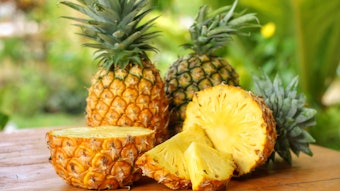
Geranyl acetate (FEMA# 2509, CAS# 105-87-3) ((2E) 3,7-dimethyl octa-2,6-dienyl acetate) and neryl acetate often occur together in nature. The choice between them is not exactly obvious, but I lean towards geranyl acetate. Both chemicals have dominant rose notes, underlaid with equally attractive fruity nuances. Neryl acetate is very interesting but a subtle metallic hint puts it at a slight disadvantage compared with geranyl acetate. In some instances, especially citrus flavors, a combination of the two esters is very effective, but in most cases, geranyl acetate is preferred.
Note that the dose rates given throughout this article are the levels suggested for use in flavors intended to be dosed at 0.05% in ready-to-drink beverages or in a simple bouillon
Floral flavors
Bergamot: Rose is not exactly the dominant floral note in bergamot flavors, but it does add a very attractive subtlety to the floral complex at around 2,000 ppm.
Elderflower: The same comments also apply to elderflower flavors. Here the rose and fruity notes blend in very well with the bright hedgerow flower top notes at levels of addition in the region of 150 ppm.
Neroli: The popularity of neroli (orange flower) flavors is mostly limited to France and North Africa. As was the case with the previous two flavor types, the main benefit of geranyl acetate is to add welcome complexity. The ideal level of addition in neroli flavors is around 2,000 ppm.
Rose: The effect of rose flavors is simply to add a fruity note, which is very effective especially in flavor usage. A good starting point is 1,000 ppm.
Tea, Earl Grey: Ideally, Earl Grey flavors should be substantially based on bergamot oil, but cost considerations often intrude to make this difficult. At 2,000 ppm of geranyl acetate, it adds complexity to compounded Early Grey flavors.
Berry flavors
Blackberry and Raspberry: Good blackberry and raspberry flavors should contain either damascenone or one of the damascones. The combination of geranyl acetate with this damson character is especially attractive, even at modest levels of addition, such as 200 ppm.
Blackcurrant: Caution is not really called for in blackcurrant flavors and 800 ppm is a good initial level of addition.
Blueberry: The same comment (for obviously different reasons) applies to blueberry flavors. An ideal level is 600 ppm.
Strawberry: Geranyl acetate is helpful in all types of strawberry flavors to round out the profile and adds depth at 300 ppm.
Citrus flavors
Grapefruit: The effect of geranyl acetate is probably most subtle in grapefruit flavors, adding softness and fruity characters. A reasonable starting point is 200 ppm, but higher levels are interesting.
Lemon: Both geranyl acetate and neryl acetate find a natural home in lemon flavors and are best used in combination at equal levels. At 1,000 ppm of each, it is ideal and takes the synthetic edge away from high added levels of citral.
Lime: The optimum level of addition for lime flavors depends on the type of lime. A low starting point is 600 ppm, but higher levels work well in cold-pressed lime and lemon-lime flavors.
Orange, Sweet: Low levels, in the region of 200 ppm, work best in sweet orange peel, orange juice and bitter orange flavors. Higher levels tend to push the profile in the direction of tangerine, which may be attractive if it is done gently.
Tangerine: Much higher levels, 1,000 ppm and more, are very effective in tangerine and mandarin flavors. Mandarin flavors especially can tolerate higher levels.
Tropical fruit flavors
Banana: Banana flavors can easily be overwhelmed by the simple fruity notes of the dominant aliphatic esters. A touch of geranyl acetate, as little as 200 ppm, adds depth and realism to the fruit character.
Lychee: Lychee flavors are obviously driven primarily by rose notes, but geranyl acetate is best used at a low level, 200 ppm, to round out the rose notes rather than add significantly to them.
Mango: Mango flavors run the gamut from overtly melon confections to pungently skin dominated flavors. This ingredient works in all of them, ideally at around 400 ppm.
Melon, Cantaloupe and Watermelon: Similarly, all types of melon flavors benefit from 200 ppm of geranyl acetate.
Papaya: Geranyl acetate can play a more central role in papaya flavors, depending on the profile that is required. Typically, it is used at 600 ppm, but much higher levels can be used successfully.
Passionfruit: Here we are back to subtle additions again. An ideal level is 200 ppm to add to fresh passionfruit flavors.
Pineapple: Moderate levels are also preferred in pineapple flavors, again adding depth and authenticity. A good starting point is 300 ppm.
Soursop: Soursop is an unusual and challenging profile. Geranyl acetate can push the character subtly toward realism at 200 ppm.
Orchard fruit flavors
Apple: Geranyl acetate is a far from obvious component of apple flavors but as little as 100 ppm makes a significant difference to a flavor that can easily be over bright and thin.
Apricot and Peach: Both apricot and peach flavors benefit from the addition of this ingredient. Levels vary but 500 ppm is a decent starting point, perhaps shading a little higher in peach than apricot.
Pear: Rose character esters are central to realistic pear flavors and there is no need for caution when adding geranyl acetate. Try starting off at 3,000 ppm but really the sky’s the limit.
Other flavors
Gin: Gin flavors are built around juniper berry oil and coriander seed oil and can easily taste thin and lifeless, with dominant dried pine needle notes. Mixing the gin with tonic helps, but not much! Geranyl acetate adds a pleasant, soft nuance to the coriander oil and also adds depth to the overall profile at 1,000 ppm.
Ginger: Ginger is an interesting and attractive profile but quite difficult to recreate or even to augment. This raw material helps and covers over some of the inevitable problem areas at 400 ppm.
Grape: Although, geranyl acetate is useful in every type of grape flavor it is probably only of marginal interest in Concord grape types. It should only be used in traces in these flavors, around 50 ppm. White grape types, especially Muscat, are a very different story. Here, 400 ppm should be a cautious starting point, but higher levels work well in very floral flavors.
Tea, Black: The floral note of tea flavors is more lavender than rose, but geranyl acetate is, nevertheless, very interesting at around 600 ppm. At this level, it adds depth and rounds out the profile.











